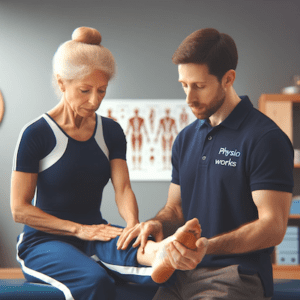Hydrotherapy

Why Consider Hydrotherapy?
Water buoyancy provides a great partial-weight-bearing environment for patients to perform their therapeutic exercises. Hydrotherapy is especially good for patients who have difficulty exercising on land, have persistent pain, or enjoy being in the water.
What is Involved in a Hydrotherapy Session?
Physiotherapists will assess you and then prescribe personalised exercises for you. Hydrotherapy exercises utilise the buoyancy of the water (floating properties). Your body weight is reduced by up to 90% in the water, making exercising very effective in improving mobility and strength. Moreover, you will not have to worry about falling over, making it the perfect place to practise your balance improvement exercises!
Is Hydrotherapy the Right Treatment for You?
You may benefit from hydrotherapy if you suffer from the following conditions:
- Chronic back pain
- Osteoarthritis
- Hip
- Knee
- Ankle
- Shoulder
- Back
- Rheumatoid Arthritis
- Post-Operative Rehabilitation:
- Total knee replacement
- Total hip replacement
- Total shoulder replacement
- Post ACL reconstruction
- Post knee arthroscopy
- Post meniscal repair
- Post-ankle reconstruction
- Overweight: Low weight-bearing exercise
- Impaired balance and risk of falling
- Cardiovascular or pulmonary conditions
Pre-Hydrotherapy Medical Clearance
If you can swim and have no open wounds, you can normally participate in hydrotherapy. If you are unsure, please check with your GP or surgeon if you have any concerns about exercising in the swimming pool.
Rochedale - Call 38410277
Book Online: RochedaleSalisbury - Call 32751044
Book Online: SalisburySandgate - Call 32691122
Book Online: SandgateMaximising Your Health with Physiotherapy Treatment
Exploring Physiotherapy Treatment for Pain and Injury
Physiotherapy treatment shines as a beacon of hope for individuals grappling with illnesses, injuries, or disabilities. Physiotherapists proactively utilise an array of techniques, including exercises, manual therapies, and soft tissue manipulation. Their professional skills extends to educating patients on managing pain, facilitating injury recovery, and retaining autonomy in daily functions.


Acute and Sub-Acute Injury Management
Physiotherapy treatment strategies are meticulously designed to address both acute and sub-acute injuries. With a focus on joint mobilisation, manipulation, and targeted soft tissue work, physiotherapists ensure each patient embarks on an efficient path to recovery. Supportive devices such as strapping, taping, and braces often complement these techniques.
Incorporating Alternative Therapies
In their holistic approach, many physiotherapists incorporate alternative methods like acupuncture and dry needling to augment pain relief and muscle function. Tailored physiotherapy exercises, ranging from stretching to Swiss ball workouts, are prescribed to meet the diverse needs of patients.
Specialised Physiotherapy Treatment
Specialised services within physiotherapy cater to specific groups and needs. Sports physiotherapy, women's and men's health, and workplace physiotherapy are distinct areas that address the particular challenges faced by different patient populations. Electrotherapy and local modalities such as therapeutic ultrasound and TENS machines represent the another side of physiotherapy treatments.
Targeted Physiotherapy Treatment for Injury Recovery
For those facing acute or sub-acute injuries, physiotherapists provide immediate and effective treatments that target pain, swelling, and inflammation. They blend traditional methods with innovative techniques to foster healing and functional restoration.
Hands-On Techniques in Physiotherapy
The hands-on aspect of physiotherapy is fundamental, with practitioners employing joint mobilisation, manipulation, and massage to catalyse healing and reduce discomfort. Ongoing learning and collaboration with other health professionals ensure that physiotherapy care is both comprehensive and customised.
Support Through Taping and Bracing
Physiotherapists are adept at applying various taping methods and supportive braces to aid in the stabilisation and rehabilitation process. They assess and determine the most suitable support mechanisms for each individual's condition.


Exercise Prescription for Rehabilitation
A broad spectrum of exercises is at the heart of physiotherapy treatment plans. From enhancing muscle flexibility to improving balance and proprioception, physiotherapists deliver evidence-based exercise regimens aimed at optimising recovery and function.
Biomechanical Analysis for Customised Care
A thorough biomechanical assessment underpins the physiotherapeutic approach, guiding the development of personalised treatment plans. This detailed analysis ensures that interventions are accurately targeted to address specific issues.
Specialised Physiotherapy Treatment Modalities
Hydrotherapy and sports physiotherapy offer targeted treatment options for individuals with specific needs, from aquatic exercises to specialised programs for athletes. Vestibular physiotherapy is dedicated to resolving balance disorders and associated symptoms.
Gender-Specific and Workplace Physiotherapy
Addressing the unique health concerns of both men and women, gender-specific physiotherapy utilises techniques like pelvic floor exercises. In the workplace, physiotherapy focuses on preventing and managing job-related injuries, contributing to a healthier work environment.
Conclusion: The Journey to Wellness with Physiotherapy
In conclusion, physiotherapy treatment is a richly diverse field, providing individualised care and a broad range of techniques to support patients on their path to recovery. It's essential to engage with a professional physiotherapy team to develop a tailored approach for achieving personal health and wellness objectives.
Related Articles
- Manual Physiotherapy Techniques: Focusing on joint mobilisation, manipulation, and soft tissue work, this article is ideal for readers seeking to understand the hands-on aspect of physiotherapy.
- Physio Instrument Mobilisation (PIM): This article covers the use of instrument-assisted mobilisation in physiotherapy, providing insights into how these tools aid in treatment.
- Essential Guide To Muscle Treatment: It gives an overview of muscle treatment practices in physiotherapy, including rest, ice, and heat therapies. It's helpful for readers wanting to know about muscle recovery.
- Dry Needling - An Effective Physio Treatment Explained: This article dives into the benefits and applications of dry needling in rehabilitation, discussing its effectiveness in pain management, improving joint mobility, and releasing myofascial trigger points.
- Physiotherapy & Exercise Prescription: It highlights the importance of tailored exercise regimens in physiotherapy, discussing how physiotherapists use their knowledge of exercise physiology to craft personalised treatment plans.
- Acute Injury Treatment - Soft Tissue Recovery Tips: This article offers tips and strategies for the recovery of soft tissue injuries, focusing on the role of physiotherapy in the healing process.
- Electrotherapy & Local Modalities: This piece explores physiotherapy treatment modalities like ultrasound and tens machines, and their role in treating pain disorders.
Need Some Help? Book Your Physio Solution Now!
Rochedale - Call 38410277
Book Online: RochedaleSalisbury - Call 32751044
Book Online: SalisburySandgate - Call 32691122
Book Online: SandgateWhen Should You Commence Physiotherapy?
In severe cases, it is best to commence physiotherapy as soon as possible. However, it does vary from case to case. Your physiotherapist has some nifty tricks to improve your pain straight away.
If you are unsure what to do, please call us for advice. We’ll happily guide you in your time of need. Often a bit of reassurance is all that you will need.
How Much Treatment Will You Need?
After assessing your injury, your physiotherapist will discuss the injury severity with you and estimate the number of treatments needed. No two injuries are ever the same.
Your treatment will include techniques and exercises to regain your:
- joint, ligament and soft tissue mobility
- muscle strength, power and speed
- balance and proprioception
- prevention tips
- performance improvement.
What If You Delay Treatment?
Research tells us that symptoms lasting longer than three months become habitual and are much harder to solve. This can lead to nastier conditions. The sooner you get on top of your symptoms, the better your outcome.
All injuries are different, and little variations can significantly improve your recovery rate. Stiff joints or muscles may need some range of movement exercises. Other injuries may require massage or particular strengthening exercises.
Seek professional guidance promptly for your best outcome.


